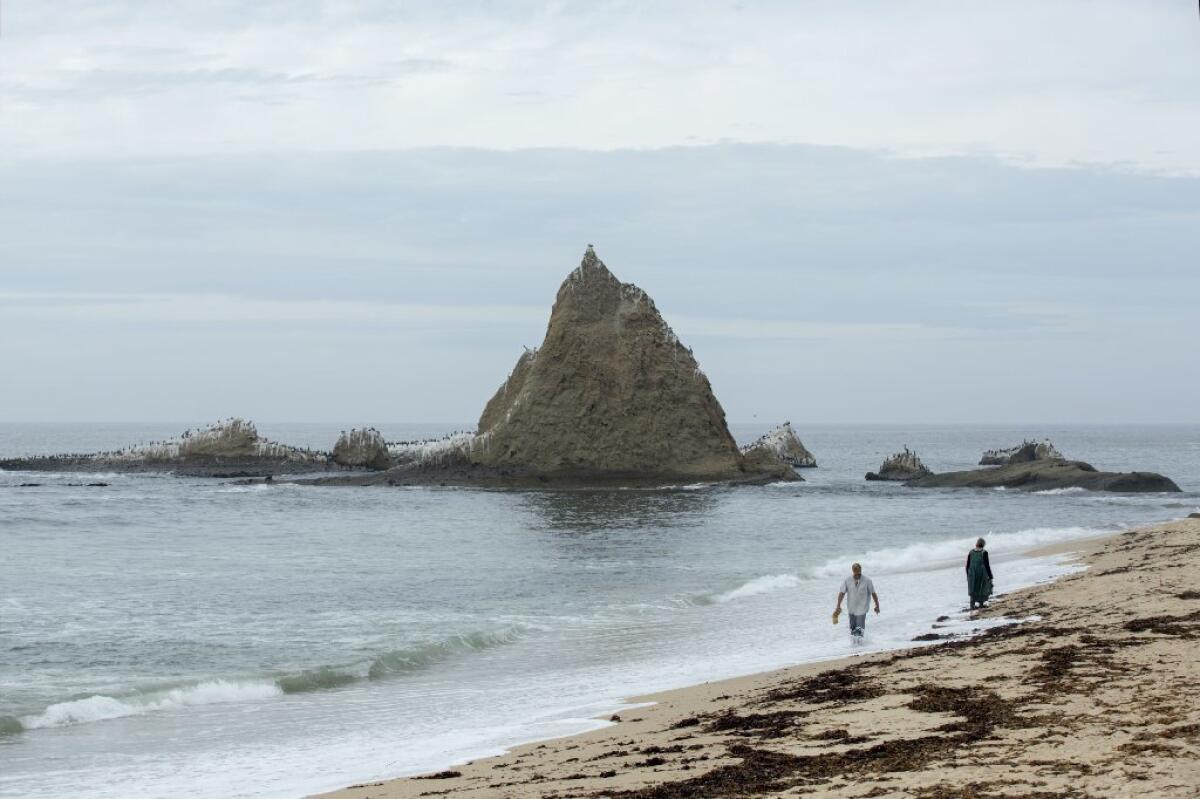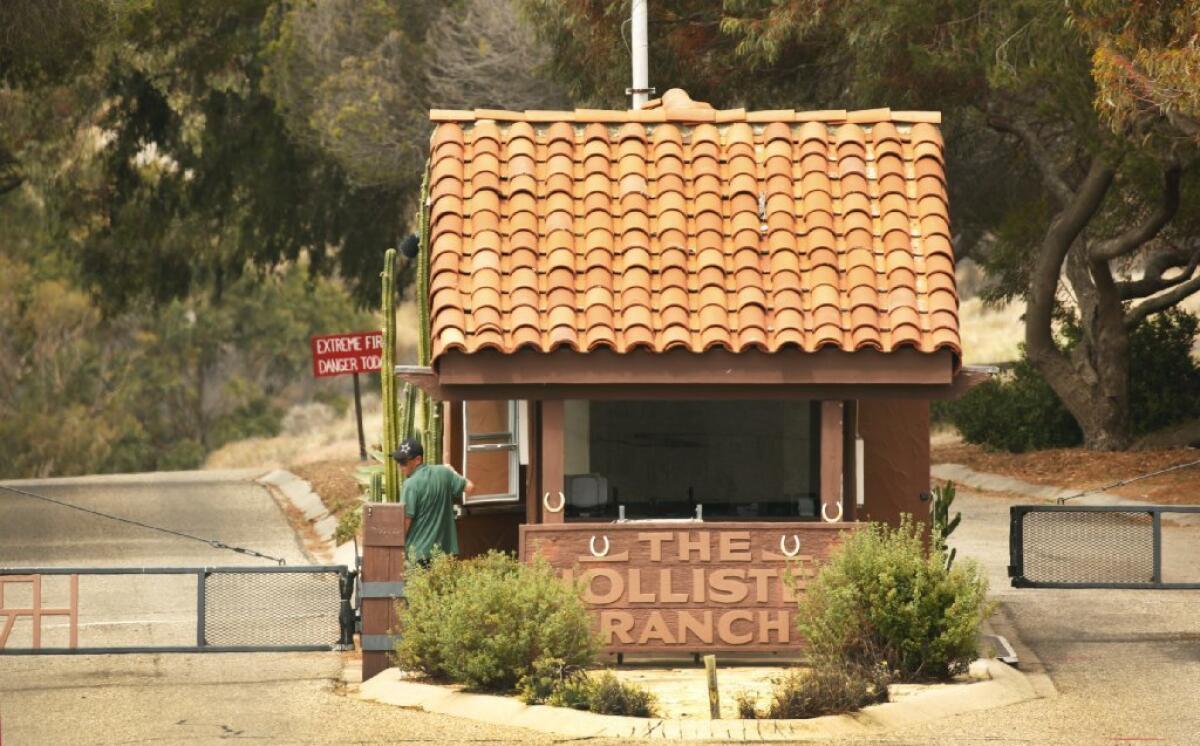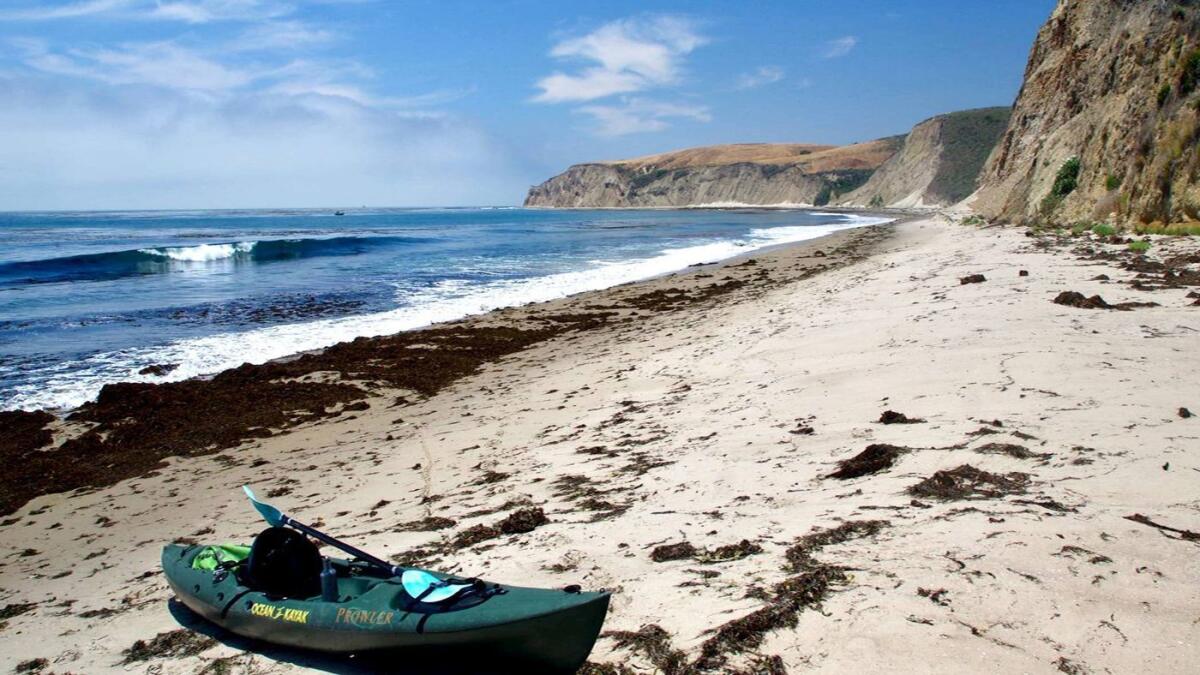These California beaches have long been off-limits. But public outrage is changing the tide

- Share via
Behind the exclusive gates of Hollister Ranch are some of California’s most-coveted beaches and surf breaks. Few have had the chance to visit them.
But earlier this month, after decades of pushback and stalemates, state officials passed through these gates with the cooperation of the ranch’s powerful landowners. For the first time in years, they traversed the pristine 8.5-mile shoreline to establish initial boundaries that could be used for an ambitious public access program.
It’s one of many milestones this year in the escalating fight to open California’s coast to everyone. An all-out legal battle over Martins Beach near Half Moon Bay culminated with the nation’s highest court rejecting a Silicon Valley billionaire’s appeal to lock the gate on his terms. A Santa Cruz neighborhood that for decades has charged a fee recently agreed, under state pressure, to open its beach for free.
And though beach access at Hollister Ranch remains limited to landowners, select visitors and those strong enough to paddle in, coastal officials have declared they will find a way to open up this stretch of Santa Barbara County coastline once and for all.
The California Coastal Act proclaimed in 1976 that the beach is for everyone — not just for those fortunate enough to own an oceanfront home. The state over the years has chipped away at locked gates, private roads and neighborhoods that try to keep out the public. What’s left are access battles against those with the means to fight back in court in perpetuity.
“This is a long game that over the last 40 years has gotten over a thousand points of public access, and we’re actually down to a handful of holdout cases: Hollister Ranch, Martins Beach,” said Coastal Commissioner Aaron Peskin, who urged the public to keep the pressure on not only the commission but also incoming Gov. Gavin Newsom and new coastal appointees.
“The time is right, so strike and make progress.”
Read more: There are more than 1,000 beach access points in California. A new app shows you where »

Coastal access — often jostling for priority with wildlife protection, plastic pollution, offshore drilling and other high-profile environmental issues — has captured California’s attention in ways that did not resonate in years past. The issue has taken on new meaning as conversations of equity dominate politics.
“I’ve talked about access for years, and this issue just didn’t have the same impact and understanding and reception that it is now getting — not just from decision makers but also from my conservation colleagues,” said Marce Gutiérrez-Graudiņš of Azul, a group that aims to bring more Latino voices to coastal issues. “I think there are a lot of things that are coming together, finally, at the right time.”
She points to decades of work by advocates such as Robert García of the City Project and the Free the Beach! study. They pushed for California’s new environmental justice law, which explicitly authorizes coastal officials to consider not only impacts to plants, animals and coastal habitats when making decisions, but also the effects on underrepresented communities.
The more people have opportunities to go to the beach, the more they will care about protecting these environments, Gutiérrez-Graudiņš said. “There’s an assumption that these communities don’t really care about beach pollution or conservation or that we only care about access — but in reality, it’s all linked.”

Equity became a rallying cry this year at Hollister Ranch. The fight to open some of the state’s most unspoiled beaches had seemed like a done deal in favor of ranch owners, who have long contended the environment has benefited from their private stewardship. Coastal officials, in a controversial agreement struck behind closed doors, ceded a contested claim to access by land.
As news trickled out, more than 1,500 people emailed the commission lambasting the deal. Others drove seven hours from Riverside to a commission meeting in Santa Cruz to plea the case for access. The state changed course and has now teamed up its agencies to finish what was promised decades ago.
The latest strategy relies on updating a ranch-wide access program that the state had adopted in 1982 after a complicated legislative history and long standoff with resistant landowners.
California beaches are supposed to be public. So why is the Hollister Ranch coast an exception? »
The program includes a walking trail and bicycle lane that would run parallel to the ranch’s main private road. To minimize the number of cars — in the interest of privacy and environmental protection — a van would operate from nearby Gaviota State Park to six Hollister beaches, where there would be picnic areas and bathrooms.
The Coastal Commission, along with the Coastal Conservancy, the State Lands Commission and State Parks, is working quickly to update the plan — which officials say does not need a major rewrite.
State Lands this month started surveying the beaches to establish the mean high tide line, which separates public from private land, and coastal officials have established an email account to collect ideas and public input on what an access plan today should include.
“We have an aggressive timeline. We want to move forward on the program as quickly as possible, while allowing enough time for adequate public input upfront,” said Coastal Commission Executive Director Jack Ainsworth. “We don’t want to just hand a plan that we developed to the public.”
Monte Ward, president of the Hollister Ranch Owners Assn., which represents the more than 1,000 people who own a share of the ranch, urged in a letter to the commission that residents also need to play a central role in the process.
“The Ranch, landward of the mean high tide line, is our property and our home,” he said. “We propose a collaborative approach to the task of revising the 1982 Public Access Program in the hope and expectation that — working together — we can achieve success.”

Dozens of owners and ranch supporters, in detailed emails and public testimonies, have also pleaded their case to the commission. They worry that unfettered access could spoil the ranch’s coastline and undo years of effort to protect the land. They point to the temporary access that they already grant to scientists, academics, historical societies, environmental groups and schoolchildren, and question how someone unfamiliar with the rugged terrain could safely navigate the steep canyons, unpaved roads and high tides without cell service.
Many objected to their characterization as wealthy landowners who just want a private beach.
“I am not an elitist enemy of the people. I share the ranch with as many people as possible. I do not surf. I’m not trying to protect a surf break or something like that. I am concerned with the destruction of something that is deeply important to me,” Grant Fowlie wrote in an email to the commission. “I can tell you from firsthand experience that the impact on the beaches is apparent when even 10 people are there and don’t clean up thoroughly. I can guarantee that what exists would be ruined from the 100,000s of visitors that would end up against these bluffs and on the reefs.”
They spoke one after another at a commission meeting in Newport Beach this month — for the first time in years outnumbering access advocates during public comments. Some spoke of their connection to the land and its history; others pointed to the disrepair of nearby Gaviota State Park and worried how a state with limited funding could maintain the pristine coastline.
“We only have the opportunity to protect things,” Patrick Rebstock, who has ties to the ranch, said to the commission, “before they’re destroyed.”
Coastal Commission Chair Dayna Bochco listened to these comments quietly for about an hour. Then, in an unexpected outburst, she pushed back at those who worry “that access by the public is going to somehow make your pristine property no longer pristine.”
“I find that somewhat offensive. I find it to be a very subtle kind of elitism — that for some reason you’re better at protecting natural habitat than anyone else,” she said.
“I can see why for the last 36 years that people of this type of thinking have blocked the state from doing what it legally has the right to do, which is to have an access program to Hollister Ranch’s beaches,” she said. “You shouldn’t be able to enjoy it any more than any other human being. You are no better of a steward than we are.”
Access advocates praised these comments and pointed to other recent victories in the greater fight for access. Earlier that week, a push by the ranch to reject the validity of a public intervention of its settlement with the state was overruled by a Santa Barbara County Superior Court judge.
Read more: Coastal advocates challenge deal that bars public from reaching Hollister Ranch by land »
“We’re thrilled that the judge appears to understand that the public has rights here, and the public has a role here — and that was the role that was not represented when the settlement was negotiated,” said Susan Jordan of the California Coastal Protection Network.
The coalition of advocacy groups, the ranch and the state will reconvene in January to determine the future of this settlement.
“We look forward,” Jordan said, “to representing the public’s interest.”
Interested in coastal issues? Follow @RosannaXia on Twitter.
More to Read
Sign up for Essential California
The most important California stories and recommendations in your inbox every morning.
You may occasionally receive promotional content from the Los Angeles Times.











